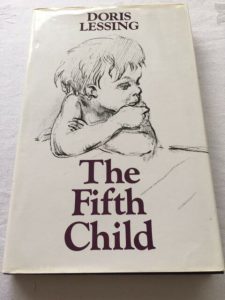 Simon Jarrett recalls a novel from the 1980s that digs out some old myths – and teaches some modern truths.
Simon Jarrett recalls a novel from the 1980s that digs out some old myths – and teaches some modern truths.
The Fifth Child
By Doris Lessing
1988.
The Nobel prize-winning novelist Doris Lessing (1919-2013) is best known for her 1950 work The Grass is Singing, which explored the racial politics of South Africa in the mid-20th century, and The Good Terrorist (1985), about a naïve young woman drawn into terrorist circles in 1980s London.
There was much more besides and one of her most intriguing works is The Fifth Child, which tells the story of Harriet and David, a shy young couple who meet in the 1960s, she an administrator and aspirant earth-mother, he an architect.
They buy a ramshackle, sprawling Victorian house in the Home Counties and while David commutes to his modestly paid job in London, Harriet gives birth to babies. Life is idyllic. They have four children in quick succession and their house becomes a cosy, slightly chaotic hub, descended on by friends and relatives and their offspring throughout the year.
One Christmas 18 adults sit around the table eating Harriet’s copious servings, while numerous children and pets rampage happily around them.
Folk myths
When Harriet is carrying her fifth baby, things seem all wrong. From five months the baby kicks relentlessly against her womb, causing her excruciating pain. She is forced to take tranquilisers and can only think of the baby inside her as ‘the savage’, or ‘the enemy’.
When Ben, as he is called, is born, his appearance and demeanour are deeply strange – “That Ben gives me the creeps. He’s like a goblin, or a dwarf or something”, remarks David’s sister.
Ben’s strangeness disrupts and eventually destroys the idyllic communal life of the cosy family home. A guest’s dog is killed one night – could Ben have done this, though still a toddler? Weeks later the family cat is strangled, and the suspicions grow. His siblings, all older, become wary, and in some cases terrified of him.
Family and friends start finding reasons not to come. Lessing draws on some ancient folk myths and intellectual theories about the disabled child. Is he a changeling, everybody wonders, a child of the devil, substituted for the ‘real’ baby that should have been born?
As he grows up, Ben starts to speak, but only to demand things, and without having gone through any of the intermediate stages of language. Doctors and other professionals are hopeless, school is predictably disastrous. An attempt to move Ben to a particularly gothic children’s institution in the far north is equally calamitous. (“They are sending Ben away because he isn’t really one of us”, explains one of his brothers).
Unexpected salvation
Salvation of a sort, when it comes, is from an unexpected source. Harriet notices that Ben is devotedly attached to John, a local unemployed youth who does odd jobs for them. Harriet sees a bond she has seen nowhere else, and pays John to take Ben off each day, on his motorbike, to hang around with his bunch of unemployed, uneducated, unqualified, drifting mates. They all ‘get’ Ben effortlessly, something which no qualified professional has ever done. They are rough and ready, teasing, politically incorrect, nickname him Hobbit; and each day he returns from their company happy.
When Ben attacks a child at school, it is not a psychiatrist who Harriet summons, but John, who tells him: “You don’t know your own strength Hobbit. It’s wrong to hurt people”. And, with a wink and a thumbs up to Harriet, John whisks the chastened Ben away on his motorbike, to the only happiness he has ever known, with the group of alienated undesirables in the local town.
Crumbling dreams
At secondary school Ben falls in with a group of similar youths, who slowly take over the family home. Is Ben falling in to crime and violence, Harriet wonders, as her old dreams finally crumble? The siblings have all got away as soon as they were old enough to leave. She envisages a new life, alone with her husband, with Ben at large in the world doing whatever it is that he does. “Would people always refuse to see him, to recognise what he was?” she wonders.
This is a powerful story about identity, acceptance, the instinctive generosity and empathy of the dispossessed, and the cruel, clinical indifference of the professional class.
